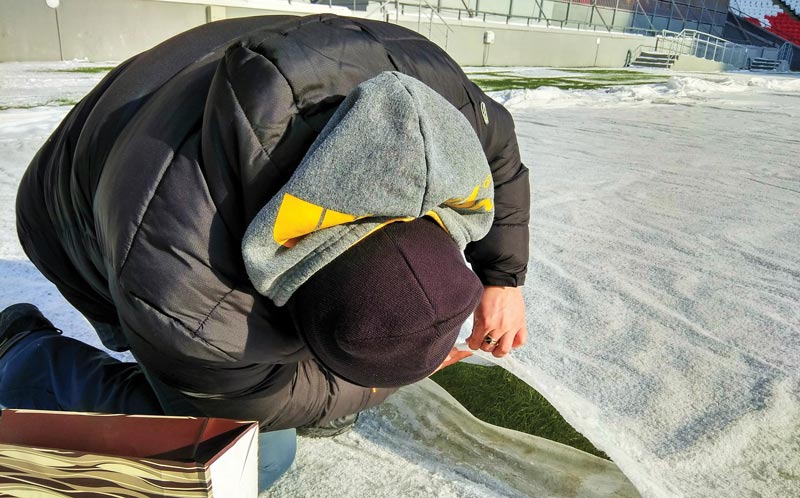
Peeking under the protective covers to assess the growth of the new turf at the 2018 World Cup host stadium in Kazan, which was renovated in December 2017 and seeded with a regular diploid perennial ryegrass + 4turf + Kentucky bluegrass blend on Jan. 20, 2018. Photo courtesy of DLF
The 2018 World Cup took place over a period of 33 days and featured a total of 169 goals scored by 122 players from 32 national teams during 64 matches in 12 stadiums in 11 cities. In addition, countless players — who may or may not have been injured — ended up writhing on the playing field. The games were clearly hard on the players, but think of the repeated punishment inflicted on the soccer pitches.
The true star of the 2018 World Cup may have been the turf, much of which was the product of seed bred and produced in the United States. The story of how Oregon seed made its way to the World Cup games in Russia began in 2011, when Leah Brilman, Ph.D., then the director of research for Seed Research of Oregon, went overseas to explore the possibility of supplying grass seed for the soccer pitches.
Seed Research had previously provided grasses for the World Cup venue in South Africa and was working for the bid in Brazil. The company also already had a seed distributor in Russia, which would facilitate importation of the products from the U.S. Seed Research expected to provide a traditional soccer pitch mixture of 20% Kentucky bluegrass (Poa pratensis) and 80% perennial ryegrass (Lolium perenne) along with additional ryegrass for overseeding.
However, in 2013, DLF-Trifolium, a Danish company with subsidiaries in numerous countries, including Russia, acquired the Pickseed group of companies (Seed Research of Oregon, Pickseed USA and Pickseed of Canada). At that point, the general assumption was that DLF would move forward without American assistance. In 2014, DLF Pickseed supplied the primary overseeded ryegrasses for the World Cup in Brazil, including tetraploid Replicator (named Double in Europe).
Never underestimate the allure of Oregon turfgrass.
By August 2017, Brilman was back in Russia consulting with venue managers regarding the grow-in of DLF’s diploid and tetraploid perennial ryegrasses.
For previous World Cup games, the grasses for all the venues had been selected by the Sport Turf Research Institute (STRI) in England, but the Russians preferred that subcontractors and turf managers from each of the 12 venues — many of which are regularly used for professional soccer — select the grasses for their sites. Ultimately, eight of the 12 venues selected DLF varieties, which had been recommended by STRI and the Local Organizing Committee for the World Cup in Russia.
The remaining venues selected grass seed from other European companies and from Jacklin Seed in Washington state. Jacklin’s Russian distributor reported that, as was the case for DLF, a blend of the company’s Kentucky bluegrass seed was used to grow sod in Russia for the pitches, and a blend of its perennial ryegrass was used for overseeding.
From DLF, the Russians selected Fiesta 4, a diploid (2n) perennial ryegrass that was already on a list of grasses approved by the Russian government for import, and the tetraploid (4n) turf-type perennial ryegrasses 4turf, Fabian and Double. The tetraploid perennial ryegrasses have twice as many genes as diploid perennial ryegrasses, are cold- and wear-tolerant, and have larger seeds, which allows them to germinate under colder soil temperatures (as low as 37.4 F [3 C]).
Compared with traditional perennial ryegrasses, the tetraploids germinate faster, are more drought-tolerant and recover from wear more quickly (a definite plus in World Cup play). The U.S. varieties, including Fiesta 4, also have a darker green color that the Russians preferred for their pitches.
In Sochi, a resort on the Black Sea, the pitches were a bermudagrass base with perennial ryegrass overseed. The more northern locations used a Kentucky bluegrass base with perennial ryegrass overseed. However, many of the pitches for competition and practice were “hybrid” fields — a combination of artificial turf overseeded with perennial ryegrass, but with no Kentucky bluegrass.
All practice pitches were constructed and maintained exactly like their neighboring competition pitches so that players could practice under conditions nearly identical to those of the actual games.
A veteran of two World Cups, Brilman says she was still somewhat surprised by her experience in Russia. In a situation where the rules are usually hard and fast, the Russians selected their own cultivars, presenting themselves as independent thinkers who relied on their own professional expertise.
Brilman’s takeaway: “You have to be respectful of other cultures. You may think you know how things should be done, but you can’t instill your way of doing things in their country because you don’t necessarily know the constraints they work under and the regulations and customs they are expected to follow.”
Teresa Carson is GCM’s science editor.